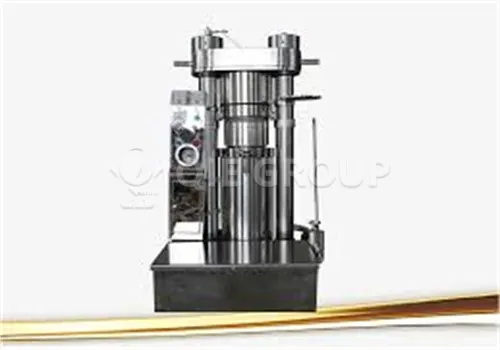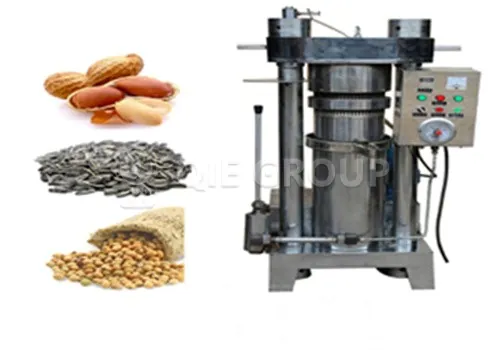In the oil processing market, the demand for "multi-seed universal equipment" is constantly increasing. Whether it's peanuts, walnuts, sesame seeds, or rapeseed, users want a single machine that can handle the different requirements for hardness, oil content, and aroma of various oilseeds. QIE Group's multi-seed hydraulic oil press addresses this industry pain point by implementing systematic engineering optimizations in structural design, pressure control, temperature management, and oil quality protection, helping oil mills achieve higher oil yields and more stable oil quality.
This article will break down the core technologies of the equipment, its real-world data performance, and the pressing strategies for different oilseeds from a professional perspective. It will also share practical application cases and maintenance tips to help users choose equipment more scientifically.

Based on extensive feedback from oil mills and on-site records from engineers, users' most pressing concerns tend to fall into three categories:
Different oilseeds vary greatly in hardness: walnut shells are hard, peanuts are soft, sesame seeds are small, and rapeseed is difficult to press.
Poor versatility is the biggest pain point of traditional equipment.
Vitamin E and unsaturated fatty acids, in particular, are extremely sensitive to temperature.
Insufficient pressure, excessively high temperature, or inadequate pretreatment can all lead to a 2% to 5% decrease in oil yield.
Our multi-oilseed hydraulic oil press addresses these three points one by one.
The hydraulic cylinder is made of high-strength alloy steel with a pressure resistance of >300MPa.
Pressure stability ±3% to avoid uneven pressing.
Pressure can be automatically adjusted according to oilseeds.
Peanuts: Medium pressure
Walnuts: High pressure
Sesame seeds: Low pressure, slow pressure
Rapeseed: Medium pressure + preheating pressure boosting
Engineer's experience: Higher pressure is not always better.
For example, with sesame seeds, if the pressure is too high, it can actually "lock in" the oil, reducing the oil yield by 1-2%.
The pressing chamber is made of wear-resistant alloy steel, and its structure is reinforced to address the differences in hardness among different oilseeds.
Hard oilseeds (walnuts) : Utilizes a wear-resistant reinforced press sleeve.
High-oil-content oilseeds (sesame, peanuts) : Designed with increased oil overflow outlets.
Fine oilseeds (sesame) : Add a precision filter plate to prevent leakage.
The machine truly achieves "adaptability to various oilseeds without replacing major components".
Why is cold pressing so important for oil quality?
Because according to industry data:
When the temperature exceeds 80°C
→ Vitamin E loss can reach 40%.
When the temperature exceeds 100°C
→ Unsaturated fatty acids may be oxidized
Keep below 60°C
→ It can retain 85% to 90% of the nutrients.
We make cold pressing possible through a temperature control system, slow hydraulic rhythm, and a cooling structure for the pressing chamber. 🔗 [ Cold Press Oil Machine: Working Principle and Main Advantages ]

To avoid errors caused by single equipment or individual cases, the table below is compiled based on the reference data range of common hydraulic cold pressing processes in the industry (not as fixed values, but only for equipment selection and process judgment).
| Oilseed varieties | Typical oil content (%) | Oil yield (%) in the hydraulic cold pressing industry | Optimal process parameters (cold pressing conditions) |
|---|---|---|---|
| peanut | 45-55 | 40-46 | Medium pressure, light drying (moisture content 5–7%), uniform crushing |
| Walnut | 60-65 | 50-56 | High pressure + slow pressing; maintaining low temperature of raw materials to prevent oxidation |
| Sesame | 50-55 | 44-50 | Cold-pressed at low temperature (<60 °C), lightly toasted (optional) |
| rapeseed | 40-45 | 34-38 | Proper preheating and thorough crushing are necessary; maintain stable moisture content. |
👉 This value represents a common range in the industry. The actual oil yield will be affected by factors such as pretreatment intensity, material moisture content, impurity content, and primary/secondary pressing methods. Low-temperature cold pressing is usually about 5-10 percentage points lower than hot pressing, which is within the normal range.
Whether you're making healthy cooking oil at home, running a small oil mill, or even managing a medium-sized oil plant with a daily capacity of several tons, QIE's hydraulic oil presses can flexibly meet your needs. The home kitchen version features a compact design and is easy to operate; the small oil mill version emphasizes automated control to reduce manpower; and the medium-sized oil plant version focuses on stable efficiency and 24-hour continuous production capacity.
Q1: Why is the oil yield so low?
Many users have reported unsatisfactory oil yields, mainly due to excessively low operating pressure or insufficient crushing of the feed. It is recommended to adjust the pressure according to the type of oilseed and to perform proper pretreatment.
Q2: What are the precautions for pressing oilseeds?
The key is to adjust the hydraulic pressure and control the pressing temperature to avoid overloading the equipment. Regular maintenance of the pressing chamber and screw is essential to ensure they can handle oilseeds of varying hardness.
Q3: Why is there such a big difference in the oil yield of the same oilseeds in different oil mills?
The differences mainly come from pre-processing conditions, including particle size, moisture content, light drying, and whether or not to press twice. Inadequate pre-processing can reduce the oil yield by several percentage points.
Q4: Does a hydraulic oil press have a higher oil yield than a screw oil press?
Hydraulic oil presses may have a slightly lower oil yield than screw hot presses, but their advantage lies in low-temperature, low-speed, and high-pressure processing, which better preserves nutrients and natural aroma. Proper pretreatment (uniform crushing, moderate moisture content, and light drying) can significantly improve the oil yield.
Our hydraulic oil presses are equipped with an automated control panel, simplifying the operation process. Routine maintenance includes checking the hydraulic oil level, cleaning residue, and regularly replacing seals to ensure the equipment's longevity and stable operation.











